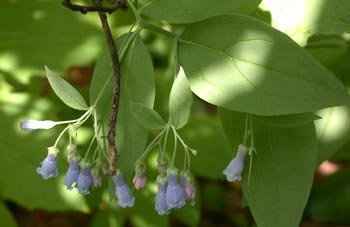Mountain Bluebells

Common Name(s):
Mountain Bluebells
Tall Fringed Bluebells
Scientific Name:
Mertensia ciliata (James ex Torr.) G. Don
Scientific Name Synonyms:
None Known
Symbol:
MECI3
Description:
Life Span: Perennial
Origin: Native
Growth Characteristics: Mountain bluebells is a tall forb, growing up to 3 feet tall, with thin rhizomes
Flowers: The blossoms are ½ inch or more long, bell-like, nodding and blue with tinges of pink. There are several blossoms occurring in branched, open clusters.
Fruits/Seeds: Nutlets, in fours, dark brown or black when mature.
Leaves: Mountain bluebells leaves are blue-green in color and have distinct lateral veins. The basal leaves, when present, are elliptic or oval in shape (generally not heart-shaped), and long stalked. Stem leaves are alternate, and become slightly smaller as you move upward along the stem. The stem leaves are lance-shaped.
Stems: Numerous Stems, 1 to 3 feet tall.
Ecological Adaptions:
Mountain bluebells prefers constant moisture, and thus is often found along streambanks, in wet meadows, damp thickets, and wet cliffs, at elevations between 5000 and 12,000 feet.
Soils: It is found on wet, but not saturated, medium and coarse textured soils. Not tolerant of salinity.
Associated Species: Engelmann’s Spruce, Sub-alpine fir, aspen, Richardson’s Geranium, Fendler’s meadowrue, Kentucky bluegrass.
Uses and Management:
Mountain bluebells is palatable to all livestock but is especially relished by both sheep and goats.
The flowers of mountain bluebells are edible raw. The leaves are edible raw or cooked. The plant is galactogogue, and a tea of the plant was used by the Cheyenne Indians to increase the milk flow of nursing mothers. They also made a tea of the powdered root and used it to relieve the itching caused by smallpox and measles.

